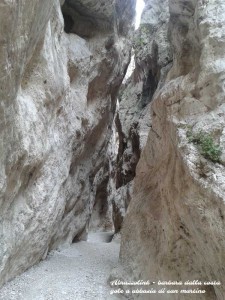San Martino in Valle Abbey
The Fara San Martino Valley, the longest and one of the most spectacular in the Apennines, is a place of particular charm and appeal.
There are several legends surrounding the origin of the gorge. The Christian tradition reports that the gorge was created when Christ died on the Cross, as a result of the earthquakes that occurred when he breathed his last breath .
Another legend, with a pagan influence and related to the cult of Hercules, claims that the gorge was opened by San Martino with the strength of his elbows to make easier the access to the Fara mountain and to build the Church of San Martino in Valle.
Both show the mystery and charm that the visitor feels in this place.
And right at the entrance of the gorge, called by the locals stretto (narrow), you can see the ruins of an entrance door. The gorge was in fact also the entrance to the monastery and to the Benedictine Abbey of San Martino in Valle which lays about fifty meters ahead, adjacent to a cliff that sheltered it. Above the door there was a painting of San Martino which clearly indicated to the traveler that he was entering a territory under the Monastery of San Martino in Valle fief.
On September 8th, 1818, the Abbey, dating from the ninth century, was completely buried by a flood. The first excavation took place in 1891.But only the top of the bell tower was visible until the conclusion of the recent archaeological excavations – from 2005 to 2009 – that brought to light the entire monastic complex.
Currently, of the monumental rupestre complex, are visible the ruins of the church, the bell tower, a large yard and more monastic buildings constructed under the rock from the ninth to the eighteenth century.
It’s likely that since its foundation the Benedictine monastery was dedicated to San Martino di Tours, Bishop and Confessor, who was the subject of one of the most vivid cult in the Middle Ages.
Written sources and archaeological evidence tell us about the importance that the monastery had in the process of the Maiella monastic colonization, like San Liberatore, to which refers the general plan of the complex, and San Salvatore a Maiella whose documents depict the redependency lationship among the powerful Benedictine foundations of Santa Maria di Farfa, Monte Cassino and San Vincenzo al Volturno.
It’s possible that the monastery was built on the site of ancient caves consecrated to ancient pagan cults, which in the Middle Ages were transformed into places of election of the local hermits.
In May if it happens to you to be in the vicinity of the Abbey, you can attend to an ancient tradition of the place: the N’dorcia. It is a procession organized by the devotees of San Martino hermit from Atessa (not to be confused with San Martino Bishop of Tours which gives its name to the monastery and the village) who go on foot from Atessa to the Abbey carrying a huge candle adorned with leaves (the n’dorcia) that will be left on the ruins of the archaeological site. they do thi in order to beg hermit Martino for the grace of a good harvest, according to his requested before his death, when he greeted and blessed his countrymen from Atessa.
During the pilgrimage it is customary to gather along the canyon some pebbles that will be scattered in the fields as a sign of fertility.
Visit Le Gole e l’Abbazia di San Martino in Valle with Barbara Dalla Costa
[gdl_gallery title=”” width=”200″ height=”200″ galid=”le-gole-e-labbazia-di-san-martino-in-valle” ]





